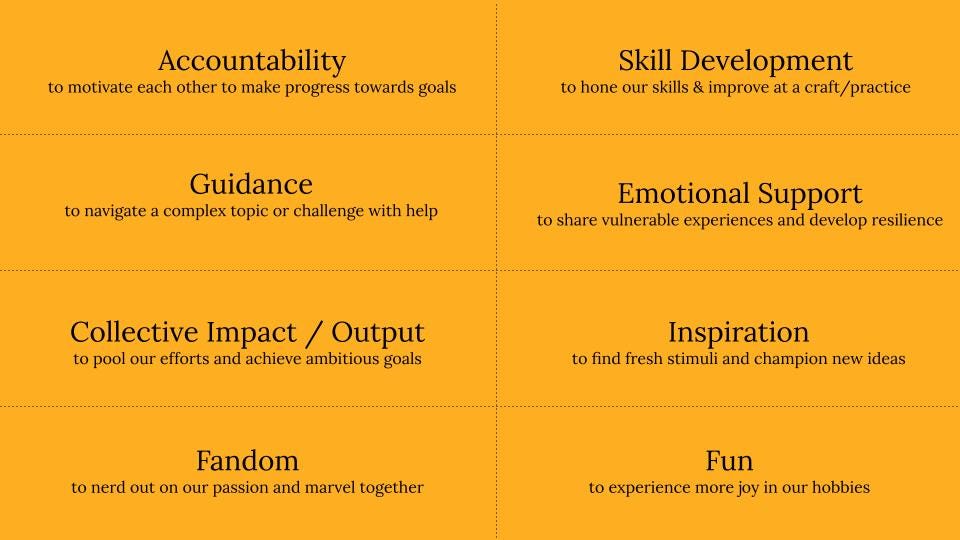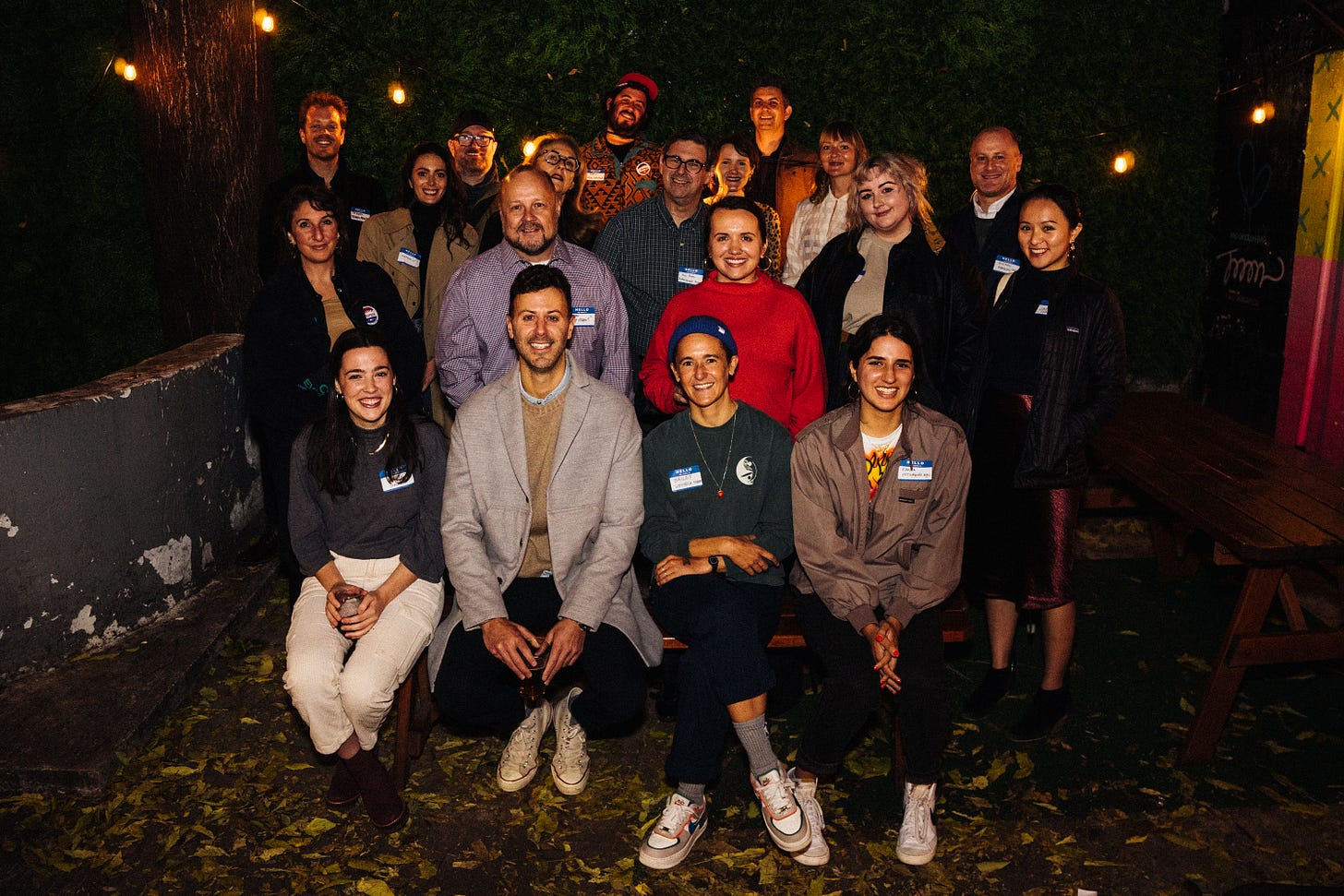Writing is so much more than hitting “publish.” Writing naturally brings together people who share an interest in a topic or a perspective on the world. By shifting from “writing for an audience” to having a conversation with readers, writers can unlock inspiration, motivation, and new growth opportunities. And readers will appreciate the in-depth discussions, the chance to help shape your work, and the sense of belonging that comes from being among like minds.
As Anne Helen Petersen of Culture Study writes to her readers in her one-year post:
“You made the subscriber threads the highlight of my week. You shared your stories of grief and place and weird neighbors. You asked and sought advice, and reliably suggest at least 500 new books every month. You sent me tips, and interviewed your kids about their video games, and suggested and then set the agenda for the money advice column… You made the comments section a place where you might actually want to hang out again. Whether you’re the first person in the Tuesday thread or just open the email once a week and sit with it, you have made all of this feel like community.”
Additionally, subscribers who participate in comments are more likely to keep reading, become paid subscribers, and tell their friends about your work.
On Substack, it’s easy to start conversations with and get feedback directly from your readers. In this resource, we’ll dive into tips and ideas for engaging your readers, drawing on advice from People & Company’s guide Get Together:
Pinpoint your people: Get specific about who you are talking to
Find your readers where they are: Engage with communities that might be interested in your writing
Start a conversation: Get to know your most engaged readers via a discussion thread
Do something together: Find ways to connect your readers with one another and meet them yourself
Pinpoint your people
Newsletters, like other subscription-based media, perform best when they’re highly targeted to your readership—if you’re writing for everybody, you’re writing for nobody.
Start by asking a simple question about your readers:
Who do you want to be a reader?
You can help answer this question by thinking about your current active readers, as well as who could be your most important target readers and what kind of reader your writing could resonate with.
Then get specific to describe your target reader persona:
Describe this group of people in 1-2 sentences
Include key traits they bring as readers (e.g. relevant skills, interests, motivations, experiences, or backgrounds)
Describe their reading habits and name one or two other publications they might read (you might even include these on your About page)
What gaps exist in their current reading repertoire, and what differentiates your publication from the rest?
Bonus: Add specific names/personas to bring these readers to life
The authors of Animation Obsessive, who worked on defining their readers as part of their Grow fellowship, reflected on how they understood their Substack readers in comparison to other platforms. They said:
“We learned a few things about our long-form readers. For one, they’re older. While Generation Z is an important part of our audience on Twitter, most of our Substack audience is over 25, and usually over 30. Our readers’ backgrounds are different too. It’s probably safe to say that animation fans and students form the bulk of our audience on Twitter—but that’s not the case on Substack. Our subscribers are working artists, teachers, animators, filmmakers, writers, and designers, alongside a group of big names in Hollywood and beyond. We have student readers who love the newsletter, which is wonderful. But their numbers are smaller than you might expect.”
For inspiration, check out Femstreet (“Where women in tech lead, shape and fund the future”) or The Isolation Journals (“A newsletter for people seeking to transform life’s interruptions into creative grist”).
Why do they read?
Now that you know your “who,” you need to understand why your readers will return to your writing. Your “why” is the core purpose driving your content that keeps readers coming back.
This can be difficult to figure out. To help, consider some of these reasons why readers might rally around your publication, and see what resonates with you:

Asking more about your readers and why they show up could even shape your publication’s description and About page.
Read: Pinpointing your “who” and “why”
Find your readers where they are
Now that you’ve identified your target reader, you’ll want to go to where they might be congregating on- and offline, whether conferences, a Facebook group, a subreddit, or a Discord server. These readers are likely already connecting with each other in another space, and they need to discover you!
Once you’ve pinpointed who your readers are, identify and visit the spaces they’re already a part of. This can both help new readers find you and help you understand them better too. Some examples of how writers are accomplishing this:
Jessica Wilen of A Cup of Ambition is a member of Facebook groups for moms
The authors of Brent and Michael Are Going Places contribute to a subreddit for digital nomads
The writers of Reboot are frequently in conversation with professors and students on college campuses
Tony Mecia, who writes The Charlotte Ledger, finds new readers by partnering with a Charlotte radio station and local Facebook groups
Elizabeth Held sent cold emails to other Substack writers in her field when she started What To Read If saying she was a fan of their work. In turn, they featured her Substack and helped her find her first readers
In these spaces, you get what you give.
Ali Abouelatta, who writes First 1000, sets aside time every Thursday to contribute to the online communities he’s a part of, including Quora, Discord servers, WhatsApp groups, and Slack channels. Ali said in a live Q&A for Substack Grow that this goodwill went a long way in creating reader advocates for his writing.
Start a conversation
Begin by getting to know your readers. This can happen in many ways, and you might want to start by brainstorming “what” exactly you will do together.
According to People & Company, the best community activities often have the following traits:
Purposeful: Brings your community’s “why” to life
Participatory: Gives others the chance to contribute
Repeatable: Takes place regularly, which builds a habit or ritual
One of the simplest things writers can do with their readers on Substack is post discussion threads or add Chat to their publication.
Terrell Johnson of The Half Marathoner writes:
“[Threads have] become one of the best things I offer my subscribers. I was impressed by the level of knowledge that my subscribers demonstrated in the conversation, but also by the back-and-forth chats once the conversation got going.”
In his guide to discussion threads, Terrell recommends that writers ask specific questions rather than vague ones, respond to as many people as possible, post threads at a regular day and time, and encourage readers to share personal experiences.
Some other examples of creative discussion threads:
Marc Stein hosted an NBA prediction contest
E. Jean Carroll solicits hilarious breakup stories
New_Public prompts readers to imagine a public library for the internet
Sarah Bessey asks for help assembling a Christmas gift guide
To create a discussion thread, go to your publication dashboard and click “New thread” in the right-hand sidebar.
In contrast to discussion threads, Substack Chat is a dedicated space for casual conversations with your subscribers.
The Chat space in the Substack iOS app allows you to share quick updates, photos, and discussion prompts on the go; and makes reader engagement more vibrant through features like image replies and emoji reactions. Notifications for new chat threads and replies will use push notification instead of email.
See how other writers are using Chat:
Suleika Jaouad kicked off with a huge introduction thread
3W/3M hosted a live watch party for the movie Alien
Bernard Hickey shares news updates every morning
Hunter Harris solicited reactions to the latest episode of Love is Blind
WendyMac asked readers to share their drawings
TicTocTrading gave out midday trading tips
Elle Griffin shared a favorite recent read
Darryl Cooper prompted readers to react to his latest podcast
It should feel low pressure, like sending a text to your subscribers.
Read more: Getting started with Chat
Do something together

Threads aren’t the only way Substack writers are engaging with their readers. Return to the reason your readers come together, and design a shared activity around that purpose. A few ideas to get you started:
Reader Q&As: Nick Offerman of Donkey Thoughts follows his Saturday threads with in-depth answers to a selected reader question posed in the comments. Emily Oster of ParentData publishes responses to questions her paid subscribers submit, covering topics from baby burping to the Doman Method.
Live virtual events: Ruth Ben-Ghiat of Lucid hosts conversational weekly Zoom Q&As for paid subscribers in addition to her essays and interviews. Suleika Jaouad of The Isolation Journals offers virtual “Studio Visits” with creatives like Lena Dunham as a subscriber perk.
In-person events: Randa Sakallah of Hot Singles and Natalie Cruz of Food For Thought take their communities from online to IRL, hosting parties and pizza tours, respectively, for their NYC-based readers.
Subscriber benefits: Michael Fritzell of Asian Century Stocks invites his paid subscribers to a private Telegram chat for discussions about stocks. Etgar Keret of Alphabet Soup offers an especially unique benefit to founding members: having a “problematic character” named after them.
Community spotlights: Mike Sykes of The Kicks You Wear describes his publication as a grassroots “community hub,” coming together around rituals like #TheKicksWeWear, a section of his posts devoted to highlighting fit pics his readers submit via Twitter.
Advice columns: Katherine Dee of Default Friend co-hosts a dating advice column called Default Wisdom with fellow Substack writer Delicious Tacos. Read more tips on differentiating and growing a Substack advice column in our conversation here.
Roll calls: Ilana Wiles of Apparently encouraged her readers to meet in real life via a roll call thread asking readers to volunteer their location. George Saunders of Story Club called for a round of introductions as if it were the first day of class.
Reader contests: Scott Alexander of Astral Codex Ten is known for his in-depth book reviews and active comments section. He brought his community deeper into the discussion by hosting a book review contest, allowing subscribers to vote and awarding winners both cash and a lifetime subscription. Three’s a party invites readers to guess the common thread between the songs they choose.
Make suggestions: Mia Billetdeaux of Borscht for Breakfast has a regular feature called the dinner conjurer, where a reader sends her five recipes they’ve enjoyed and she sends back a recipe recommendation, directly inspired by The Biblioracle Recommends.
Publishing doesn’t have to be a one-way street. We hope this resource has given you ideas for identifying and starting conversations with your readers to build a strong and loyal community around what you do.
How are you building your reader community on Substack? What great examples have you seen from other writers? Where are your favorite reader communities? Leave a comment to share your approach.









Share this post